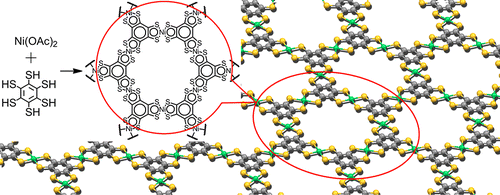Sheberla, D.; Sun, L.; Blood-Forsythe, M. A.; Er, S.; Wade, C. R.; Brozek, C. K.; Aspuru-Guzik, A.; Dincă, M. J. Am. Chem. Soc. 2014. APAP.
DOI:10.1021/ja502765n
Reaction of 2,3,6,7,10,11-hexaaminotriphenylene with Ni2+ in aqueous NH3 solution under aerobic conditions produces Ni3(HITP)2 (HITP = 2,3,6,7,10,11-hexaiminotriphenylene), a new two-dimensional metal–organic framework (MOF). The new material can be isolated as a highly conductive black powder or dark blue-violet films. Two-probe and van der Pauw electrical measurements reveal bulk (pellet) and surface (film) conductivity values of 2 and 40 S·cm–1, respectively, both records for MOFs and among the best for any coordination polymer.

- Reference
[1] Noro, S.; Chang, H.-C.; Takenobu, T. et al. J. Am. Chem. Soc. 2005, 127, 10012. DOI: 10.1021/ja052663
The semiconducting film based on bis(o-diiminobenzosemiquinonate) nickel(II) complex showed uniaxial orientation structure along the normal to the substrate and good p-type metal−organic thin-film transistor (MOTFT) character.
[2] Nishihara, H. et al. J. Am. Chem. Soc. 2013, 135, 2462.
A π-conjugated nanosheet comprising planar nickel bis(dithiolene) complexes was synthesized by a bottom-up method. A liquid–liquid interfacial reaction using benzenehexathiol in the organic phase and nickel(II) acetate in the aqueous phase produced a semiconducting bulk material with a thickness of several micrometers. Powder X-ray diffraction analysis revealed that the crystalline portion of the bulk material comprised a staggered stack of nanosheets. A single-layer nanosheet was successfully realized using a gas–liquid interfacial reaction. Atomic force microscopy and scanning tunneling microscopy confirmed that the π-conjugated nanosheet was single-layered. Modulation of the oxidation state of the nanosheet was possible using chemical redox reactions.



